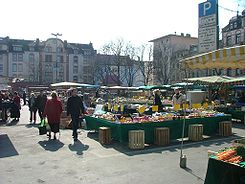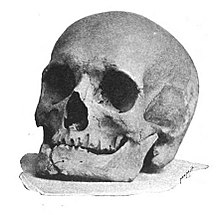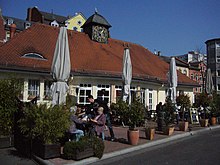Wilhelmsplatz (Offenbach am Main)
| Wilhelmsplatz | |
|---|---|
| Place in Offenbach am Main | |
 Offenbach weekly market on Wilhelmsplatz |
|
| Basic data | |
| place | Offenbach am Main |
| Created | from 1866 |
| Confluent streets | Bleichstrasse, Bieberer Strasse |
| Buildings | Market keeper's house |
| use | |
| User groups | Pedestrian traffic , bicycle traffic , car traffic |
| Technical specifications | |
| Square area | 11,850 m² |
The Wilhelmsplatz in Offenbach am Main is since 1903 as a location for the Offenbacher Wochenmarkt used which takes place three times a week. It is almost exclusively surrounded by old buildings and is lined with chestnut trees on both long sides (east and west). On the northwestern edge of the square is a life-size statue of the matchstick .
The market keeper's house that dominates the square is a cultural monument under the Hessian Monument Protection Act .
history

The cemetery of the city of Offenbach was formerly located on the site of today's Wilhelmsplatz. The graves of the Frankist heads in Offenbach's city cemetery, especially the sacred graves of Jakob Joseph Franks and Eva Franks, served the Frankists as pilgrimage sites for a long time . Secret waymarks in green indicated the location of the graves and indicated the Sabbatian appreciation of this color.
The last burial in the city cemetery took place in 1832 after the old cemetery on Friedhofstrasse was created as a replacement for the former city cemetery on today's Wilhelmsplatz. When the Offenbach city cemetery was leveled in 1866, the graves of Jakob and Eva Franks were opened. The Offenbach homeland researcher Emil Pirazzi took Jakob Frank's skull and left it on his bookcase for a few decades. Aleksander Kraushar , who visited Offenbach during his research in 1894, took a photo of it (see picture on the left).
From 1868 a cattle market was held on the square, which was now named Neumarkt to distinguish it from the actual central marketplace . In 1876 the square was named in honor of Kaiser Wilhelm I and in 1887 was given an imperial oak with a memorial stone - both were removed again in 1925. From 1903, the city moved the Offenbach weekly market from the market square to Wilhelmsplatz. As a result, the marketplace lost its central function as a trading center. In 1911 the market keeper's house (market house) was built as a shelter for the market master on the north side. This building has been preserved in its original form and is now used as a cider restaurant. It is a listed building.
On Good Friday in 1919 at the William place took Good Friday coup its beginnings. Communist forces gathered around 2,000 people there at a rally. After members of the Communist Party of Germany had stirred up the masses, they moved to Bieberer Strasse and tried to storm the barracks of the 5th Grand Ducal Hessian Infantry Regiment No. 168 .
During the time of National Socialism , Wilhelmsplatz was named Platz der SA . After the end of the Second World War , the old name Wilhelmsplatz was reintroduced.
Todays use
The Offenbach weekly market takes place three times a week on Wilhelmsplatz . Outside of market hours and on days when there is no market, it is used as a car parking lot. Several times a year, celebrations such as the artists' market or the culture festival of nations take place on Wilhelmsplatz .
In the period from September 2009 to May 2011, the square was redesigned. The 1.7 million euro building project was accompanied by a reorganization of the square, in which part of the parking space was no longer available. During the work to redesign the square, three tombs with brick vaulted ceilings and floor slabs made of reddish stone were found about 1.20 meters below the current level of the square . These were probably graves that were not cleared when the former cemetery was leveled. The found bones were reburied in Offenbach's old cemetery .
Market stalls
On the north side of Wilhelmsplatz, the market house was built between 1910 and 1911 according to the plans of the town building inspector Weil. The building was furnished with toilet facilities, a police station, a market master service and a medical station. The building is a broad, single-storey building with a mighty hipped roof , which is crowned by a clock tower . On the square side it has a smooth plastered facade with window and door openings. On the side facing Bieberer Strasse there is a sandstone fountain. A few small openings have been made in the roof of the market house by towed dormers . Since 1986 it has been converted into a kiosk and restaurant.
The building is a listed building .
literature
- City of Offenbach, Office for Urban Planning and Construction Management (Ed.): Meeting point Offenbach lifestyle: Wilhelmsplatz: its history, its renovation, its future. Self-published , Offenbach am Main 2011, DNB 101211001X .
Web links
- Website of the Offenbacher Marktbeschicker association
- The matchstick on Wilhelmsplatz in a 360 ° view
Individual evidence
- ↑ "On the western boundary wall, towards the southern end, you can notice a horizontal line of green color; from this about ten paces to the east, you notice four flat, right-angled elevations on the grassy ground, like four flattened garden beds, alternating between them The boundary forms a cross deepened in the ground; Jakob Frank rests under the southeastern burial mound, [...] under the northeastern hill rests Eva Frank, his daughter, under the southwestern Joseph Frank, his son, and under the northwestern Joseph Pawlowski, a proven one Friend and supporter of this family. The younger son of Jakob Frank, Rochus, rests on the eastern boundary wall of the same churchyard in the same line, about ten paces from the wall, which also has the green stripe as a mark. which testify to careful care. [...] "Eginhard Quelle, Das Grab eines Propheten in Offenbach, Illustrier tes family book for entertainment and instruction in domestic circles, year 7, volume 7, booklet 6, Trieste 1857, pp. 202 / 208f.
- ↑ a b c Wilhelmsplatz saw eventful city history. Archived from the original on February 5, 2015 ; accessed on January 13, 2016 .
- ^ History of the Offenbach weekly market. Archived from the original on February 4, 2011 ; Retrieved February 5, 2015 .
- ↑ Thomas Kirstein: Redesigned Wilhelmsplatz inaugurated with actions and a huge party. In: op-online.de. May 22, 2011, accessed February 5, 2015 .
- ↑ Madeleine Reckmann: No obligation to register old graves. fr-online.de, November 19, 2009, accessed on February 5, 2015 .
- ^ A b State Office for the Preservation of Monuments in Hesse (ed.): Berliner Straße 9B In: DenkXweb, online edition of cultural monuments in Hesse .
Coordinates: 50 ° 6 ′ 12.9 " N , 8 ° 45 ′ 59.7" E

